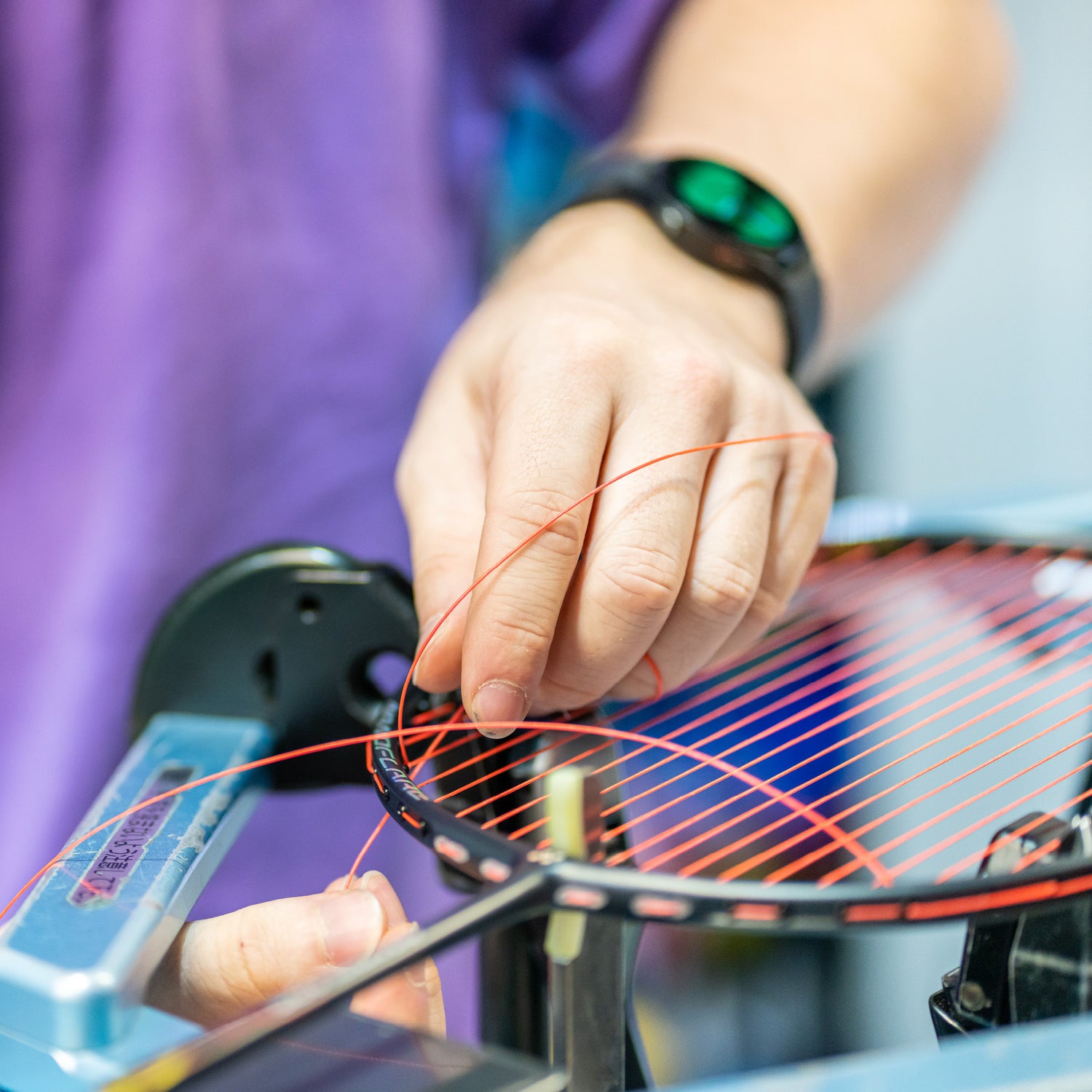What causes string breaks?
Miss hits/miss timed shots - be careful with your shots, a miss hit shot can break strings faster due to the string bed being more spread out. It’s the number one reason why a pro would break their strings.
Cold Weather/temperature change - always keep rackets in thermal bags such as the Yonex Pro or Expert range featuring the foil lined thermal pockets.
Too high tension/thin gauge - stringing your racket with ultra thin string or very high tensions will lessen the durability of the restring.
Broken/Old grommets - every once in a while you will need to keep your grommets fresh. You can do so using one of our Central Sports MOT Services.
How often should I restring?
Depending on your level, we would advise to string your racket once every 2-3 months. If you’re playing very regularly and training to a high level, then once every 2-3 weeks to preserve the tension might be needed.
You should consider restringing your racket when there is evidence of string fraying. This is common at the intersections of the strings and when it’s been used over some time. It is better to restring it before it breaks, as it protects the frame of the racket from imbalance of forces.
How long should it last?
A lifespan or guarantee is not available for a restring due to the many factors that account for their longevity. Technically speaking, your strings are at their most fragile and most likely to break fresh off the machine, as they’re at their highest possible tension. So, be a little more careful when you’re trying out your fresh strings.
So, what string should I use?
Badminton strings are typically categorised into 3 main categories:- Power string (sometimes repulsion strings)
- Control string
- Durability string
Power strings:
Power strings are made from materials that allow the strings to store more energy and release it when the shuttle is hit. This can be particularly useful for doubles players who need to cover more ground and for attacking singles players who need to generate quick, forceful shots.
However, it's important to note that while power strings may help generate more power, they may also sacrifice some control and durability. This is because the thinner gauge of the string makes it less resistant to wear and tear and also affects the level of feel and control you have over your shots.
In summary, power strings are ideal for players who prioritise power in their shots, but it's essential to consider the trade-off in control and durability.
Popular Power Strings Include:
- Yonex BG80 Power
- Yonex BG66 Ultimax
- Yonex Nanogy 98
- Yonex Aerosonic
- Ashaway Zymax 66 Fire Power
- Ashaway Zymax 64 TX
 Control Strings:
Control Strings:
Control strings are designed to provide players with greater precision and accuracy in their shots. The textured finish of the string provides more friction with the shuttlecock, giving the player more control over their shots and enabling them to play more accurate, tighter spinning net shots and delicate slices.
Typically, control strings have a thicker gauge (0.69 or above) compared to power strings. The thicker gauge provides greater durability and stability, reducing the risk of string breakage during play.
Control strings are well-suited to front court doubles players and singles players who prioritise accuracy and control over raw power. By providing a stable platform for the shuttlecock, control strings help players execute their shots with greater precision and consistency.
However, it's important to note that while control strings provide greater accuracy and control, they may also sacrifice some power.
Popular Control Strings Include:
- Yonex Nanogy 99
- Yonex BG Aerobite
- Yonex BG Aerobite Boost
- Ashaway Zymax 66 Fire
- Ashaway Zymax 68 TX
- Yonex BG80
Durability Strings:
Durability strings are designed to provide players with long-lasting performance. With a gauge of 0.70 mm or above, durability strings are typically thicker and stronger than other types of strings. This makes them more resistant to wear and tear.
These strings are ideal for players who train regularly and want to get the best value for money from their strings. By providing longer-lasting performance, durability strings help players save time and money on re-stringing and maintenance.
Durability strings are a good choice for beginner players as they are more resistant to off-centre hits and are less likely to break.
Popular Durability Strings Include:
- Yonex BG65 (Particularly suited to beginners)
- Yonex BG65Ti Titanium
- Yonex Nanogy 95
- Ashaway Zymax 69 Fire
What level of tension do I need?
This is based on 4 things:Player ability - as a general guideline, we'd suggest the below tensions based on your level. This is adjusted by skill level because to make effective use of high string tensions you need to be able to hit the “sweet spot” on the racket head when playing, and this area gets smaller the higher the tension.
- Beginner - 17lbs-20lbs
- Intermediate - 20lbs-24lbs
- Advanced - 24lbs-27lbs
- Professional - 27lbs – 30+lbs
Racket tension range: Every badminton racket has a maximum tension range that it can handle without getting damaged. It's crucial to never exceed this maximum tension range when restringing your racket, as doing so can cause the racket frame to crack or break completely.
This information can be found in the product specifications on our website and on the frame itself. We will be able to advise you on the optimal string tension for your racket and help you avoid any damage to your equipment.
Lifespan - The frequency at which you need to replace your strings depends on a number of factors, such as how often you play and the level of tension you use. Generally, a well-strung set of strings at the appropriate tension level can last a couple of months.
It's also worth noting that how you hit the shuttle can also impact the longevity of your strings. Durable strings are typically thicker and more resistant to the stress caused by off-centre hits, which can help them last longer.
Shuttlecock type - If you're playing with plastic shuttles, it's recommended to lower the string tension by 2-3lbs compared to when playing with feather shuttles. This is because plastic shuttles generally require more effort to get the desired power, and their flight can be a little more inconsistent, leading to more off-centre hits.
Lowering the string tension can help reduce the stress on your strings and make it easier for you to get the power and control you need when playing with plastic shuttles. It's important to keep in mind that different players have different preferences, so it's always a good idea to experiment with different tensions and find what works best for you.
Other Hints and Tips
High tension ≠ power - Many players believe that stringing their racket at a high tension will give them more power, but this is not always the case. Higher tension can actually make it harder to generate power and can increase the risk of injury, especially in the shoulder if you are forcing the shuttle too fast.Skill level - It's always a good idea to choose a string tension that is appropriate for your skill level, playing style, and overall physical condition. Experimenting with different tensions and finding what works best for you is key to improving your game and reducing the risk of injury.
Regular racket MOTs - Don’t forget to give your existing racket some TLC with the Central Sports Gold MOT and have your racket looking and feeling as good as any pro.





